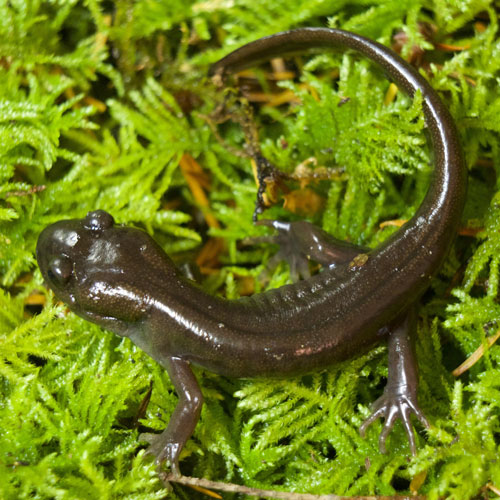How many amphibians are there in the world?
As of September 2012, there are 7,037 known amphibian species. They are broken down as follows: Anurans (frogs and toads:) 6,027 in 53 families. Caudata (salamanders): 639 in 10 families. Gymnophiona (Caecilians): 191 in 10 families.
How do amphibians breathe?
Most amphibians breathe through lungs and their skin. Their skin has to stay wet in order for them to absorb oxygen so they secrete mucous to keep their skin moist (If they get too dry, they cannot breathe and will die). Oxygen absorbed through their skin will enter blood vessels right at the skin surface that will circulate the oxygen to the rest of the body. Sometimes more than a quarter of the oxygen they use is absorbed directly through their skin. Tadpoles and some aquatic amphibians have gills like fish that they use to breathe. There are a few amphibians that do not have lungs and only breathe through their skin.
Can amphibians smell?
Yes, amphibians can smell. They have tiny openings on the roof of their mouth called external nares that take in different scents directly into their mouths. The external nares also help them breathe, just like our noses do. In some species, like many salamanders, they rely on chemical cues called pheromones for mating.
Do amphibians have teeth?
Yes, a lot of amphibians have teeth. However, they do not have the same kind of teeth that we have. They have what are called vomerine teeth that are only located on the upper jaw and are only in the front part of the mouth. These teeth are used to hold onto prey and not used to actually chew or tear apart prey. Amphibians swallow their prey whole, so they do not need teeth for chewing. They are called vomerine because they are found in the facial bone called the vomer.
What do amphibians eat?
Amphibians will pretty much eat anything live that they can fit in their mouths! This includes bugs, slugs, snails, other frogs, spiders, worms, mice or even birds and bats (if the frog is big enough and the bird or bat small enough). A few species will eat only one particular food like some smaller frogs might specialize on ants or termites. Some particularly voracious frogs/toads like the cane toad have been known to eat non- live food such as dog or cat food! Aquatic amphibians will eat bugs, other amphibians including tadpoles, fish and small aquatic organisms. There is only one frog species known that is actually a vegetarian: The Brazilian Tree frog eats fruits and berries!
What do tadpoles eat?
Most tadpoles eat plants and algae in the water. They are important grazers in aquatic systems because they help with nutrient recycling and control algae populations, which help to maintain the health of freshwater ecosystems. Sometimes tadpoles will eat each other, especially if food resources are low. Some tadpoles eat insect larvae and tiny organisms that are found in the water.
Are amphibians only active at night?
Although many species are only active at night, there are some that are active during the day. Amphibians are usually active at night because they are harder to see and can avoid being eaten. It is also easier to avoid drying out when the sun isn’t shining down on them. Poisonous amphibians that are brightly colored are often active during the day. Bright colors on an animal will warn predators that they are poisonous, so they do not have to worry about predators. They avoid drying out by living in forests or undergrowth where it is damp and the sun isn’t able to dry them out.
Do amphibians hibernate? What do frogs/salamanders do in winter?
Yes, there are many amphibians that hibernate. Amphibians do not like extreme temperatures. During the cold winter months in non-tropic areas, most amphibians will either hibernate in the mud at the bottom of water or dig down into the ground to hibernate. Some amphibians stow away in cracks in logs or between rocks during the winter. They slow their metabolism and their heartbeats down and survive off stored body reserves throughout the winter. There are some frog species that can even survive freezing temperatures by maintaining a high level of glucose in their blood that acts like antifreeze. Some of the frog will actually freeze, like their bladder, but their blood and vital organs do not freeze. The heart can stop beating and the frog can stop breathing, but it when it thaws out, it will still be alive.
Are all amphibians poisonous?
No, only some species of amphibians are poisonous. Usually they are brightly colored to warn predators of their toxic nature. Most amphibians secrete chemicals from their skin to make them taste icky to predators or make it difficult to handle them. These secretions can be slippery or can be sticky and irritating to the skin.

Amphibians & Reptiles of Washington
Do you know where rattlesnakes live in our state? Or which salamander breathes through its skin? Explore the fascinating diversity of the 26 species of amphibians and 28 reptiles found in Washington state.

